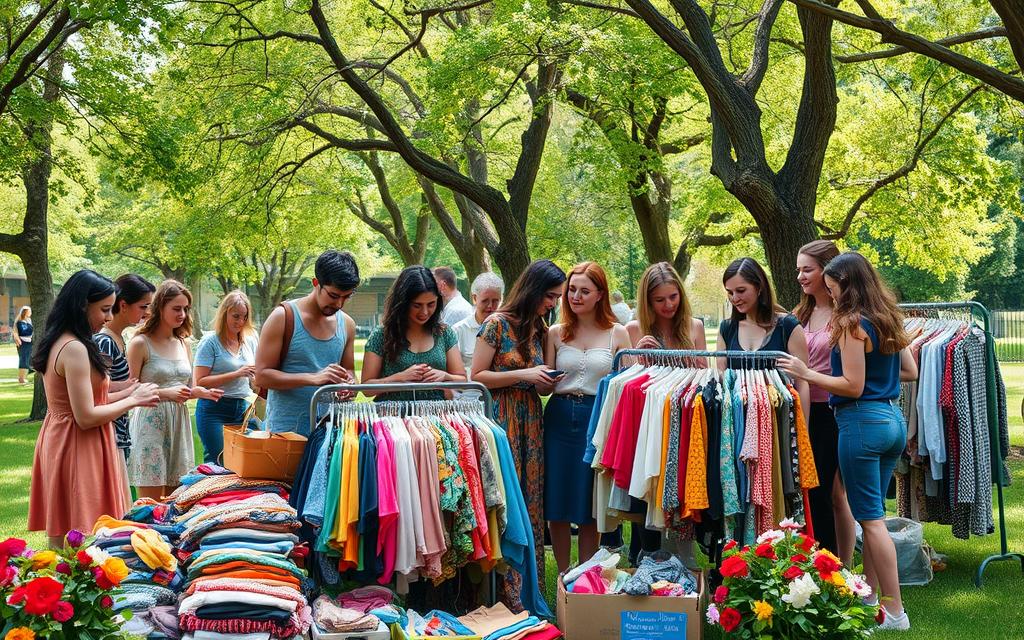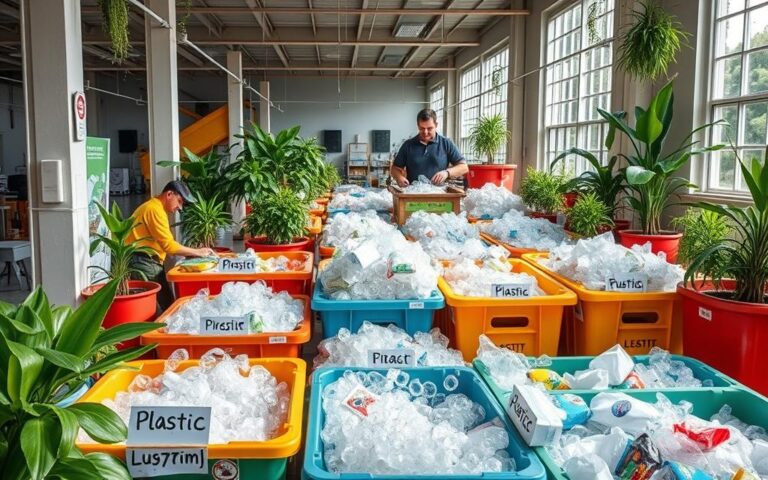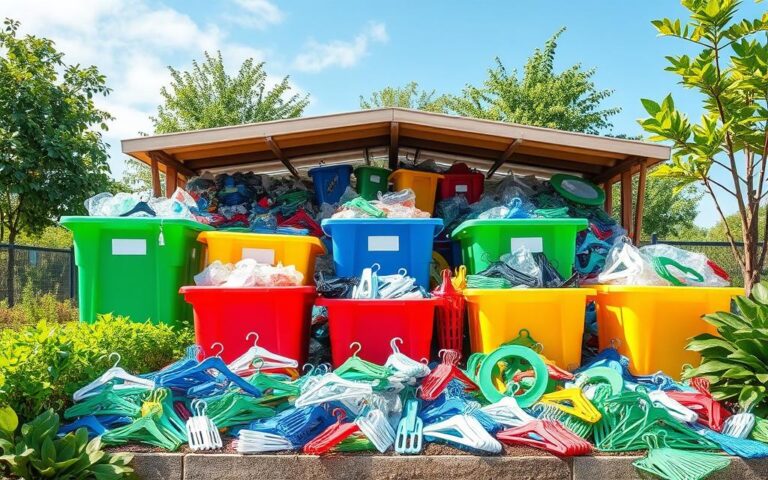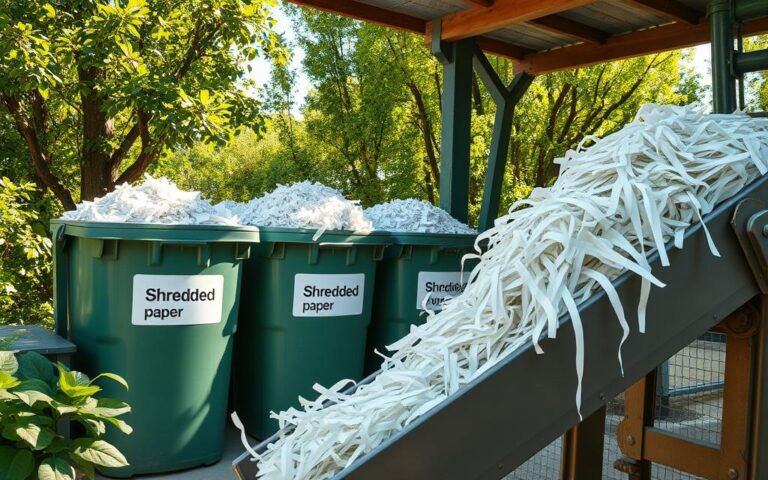Where Can I Recycle Old Clothes? Sustainable Disposal Tips
The fashion industry greatly affects our planet, causing around 10% of yearly CO2 emissions. This makes recycling clothes very important. By using eco-friendly ways to throw away old clothes, we support sustainable fashion. Let’s look at how to handle textile waste and get rid of unneeded clothes responsibly.
Every year, landfills get billions of pounds of fabric waste. This makes it crucial to choose wisely when disposing of clothes. Sort your clothes by their condition: great, good, or poor. This helps decide the best way to dispose of them, making sure many can be recycled or reused.
Joining recycling programs by brands like Patagonia, H&M, and American Eagle Outfitters helps lessen the impact. When you recycle in this way, you aid in moving towards a sustainable future. We’ll cover many ways to recycle and dispose of clothes responsibly, focusing on sustainability and helping communities.
Understanding the Impact of Textile Waste
The textile industry greatly affects our planet, especially in waste management. Did you know about 85% of used clothes end up in landfills? This leads to harmful environmental effects. Textiles may take over 200 years to break down. They release dangerous gases like methane. Clothes production also pollutes groundwater and soil with dyes and chemicals. We urgently need to adopt sustainable clothing habits. The consequences of not doing so affect us all deeply.
The Environmental Toll of Landfills
In 2018, the US added 17 million tons of textile waste to landfills. This was 5.8% of all the waste produced. Sadly, only 14.7% of this was recycled. As a result, over 11 million tons were thrown away without any attempt to reuse or recycle. This situation highlights the need for better handling of textile waste. Some companies, like H&M and Madewell, have started to take action. They offer programs to dispose of textiles responsibly.
Water and Resource Use in Clothing Production
Making clothes requires a lot of resources. For example, a single cotton shirt needs up to 2,700 litres of water. The clothing industry is growing, and so is pesticide use in cotton farming. This harms our environment. Around 60% of clothes are made from synthetic materials, making recycling difficult. Promoting sustainable clothing is essential to reduce these negative impacts. Choosing to buy mindfully can lead to industry-wide improvements.
Where Can I Recycle Old Clothes?
Recycling old clothes helps cut down on textile waste and supports sustainability. There are many ways you can do this, depending on what’s easiest for you. You can go to local recycling centres or use take-back schemes from shops. This ensures your old clothes don’t end up harming the environment.
Local Recycling Centres
In many places, you can find centres that take in old textiles. Communities often provide spots where people can bring clothes they no longer need. For example, Montgomery County has a special spot for recycling textiles and shoes. Organizations like the Salvation Army send clothes that can’t be used to recycling centres. This helps our economy by reusing resources.
In Falls Church City, there are services for recycling textiles too. It makes it easy to recycle clothes that would otherwise be thrown away.
Retailer Take-Back Programs
More and more shops are offering to take back old clothes. Stores like H&M and Uniqlo have bins where you can drop off clothes. They even give you vouchers for it. Since the pandemic, some shops have brought back these bins, helping you recycle easily.
These schemes take all sorts of textiles. This includes clothes, shoes, and even accessories. It’s a great way to dispose of unwanted items sustainably.
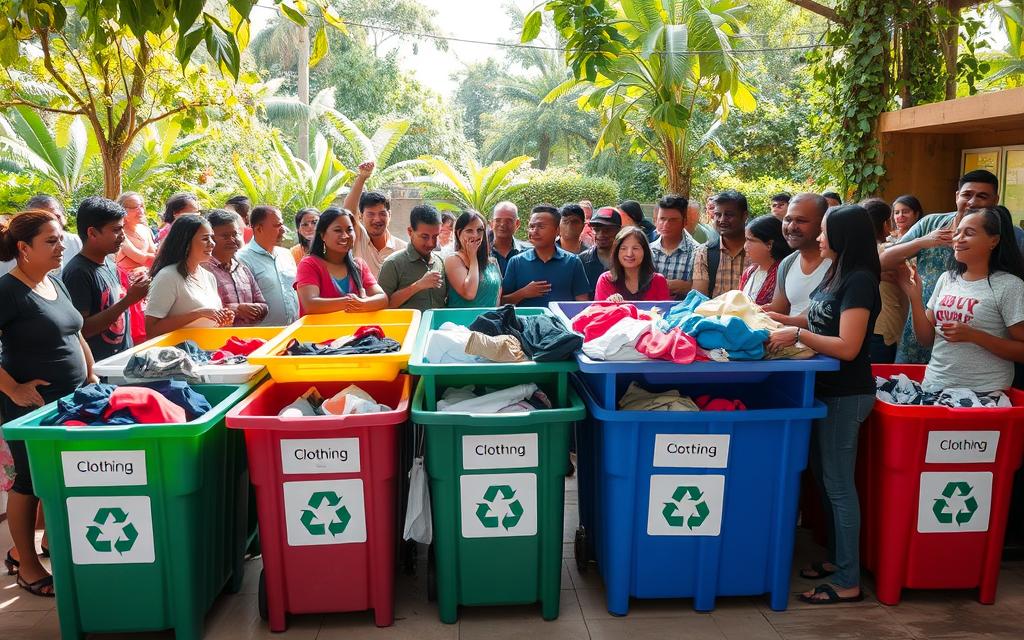
Private companies also offer textile recycling bins in cities. They’re usually in shopping centre car parks. To recycle, make sure your items are dry and mildew-free. This keeps the recycling process healthy and clean.
| Local Recycling Options | Retailer Take-Back Programs |
|---|---|
| Salvation Army donates unusable textiles to recycling centres | H&M provides textile recycling bins at their stores |
| Montgomery County offers a textiles and shoes recycling section | Uniqlo has reintroduced textile recycling bins |
| Falls Church City lists textile recycling services | Many retailers offer vouchers for recycling participation |
| Private companies provide city-specific recycling bins | Collection bins located in shopping centre parking lots |
Creative Ways to Dispose of Gently Used Clothing
Imaginative ways to get rid of gently worn clothes can help clear your closet. It also helps our planet. Selling these clothes or organizing swaps are great ideas. They support sustainable fashion and bring people together.
Selling Online and Locally
There are many ways to sell used clothes today. Online sites like Poshmark, Depop, and eBay are great for reaching more buyers. Local shops and thrift stores offer community connections. They give clothes another chance to be loved.
By selling locally, you prevent clothes from going to waste. It encourages buying second-hand. This makes a big difference in waste reduction and supports sustainable fashion.
Hosting a Clothing Swap
Clothing swaps are a fun way to update your wardrobe. Invite friends, family, or neighbours to exchange clothes. It’s a social event that also helps the planet. Everyone finds something “new” to them. It’s a joyful way to keep clothes out of the trash.
These swaps promote reusing and recycling. They show how community actions can aid sustainability. By involving people, you spread a culture of sharing. This supports green actions in the community.
The Importance of Donating Responsibly
Donating clothes thoughtfully makes a big difference. It helps those in need in a meaningful way. It also supports ethical fashion. Choose charities that focus on direct aid rather than big organisations that may not use donations as well.
Choosing the Right Charities
It’s best to choose local non-profits or smaller groups. They’re better at getting donations to those in need. Here are some initiatives that do great work:
- Patagonia’s Worn Wear reuses clothes for new purposes.
- The North Face’s Clothes the Loop offers recycling in their stores.
- Eileen Fisher’s Renew programme promotes eco-friendly fashion by reusing unwanted clothes.
Being part of these efforts helps reduce waste. It fights against the huge amounts of clothes thrown away every year in the US.
Preparing Your Clothes for Donation
How you donate clothes is crucial. Make sure they’re clean and fixed if needed. Follow these steps:
- Wash and dry to remove dirt and smells.
- Check that clothes are in good shape, without major damage.
- Mark clothes clearly to help charity workers sort them out quickly.
These actions increase the chance of your donations helping others. Donating responsibly is good for your community and the planet.
Options for Unwearable Clothing
Clothes that can’t be worn anymore don’t just have to end up in the bin. Fixing repairing damaged clothes is a great way to make them last longer. This not only helps our planet by cutting down on waste. It also means less new stuff has to be made. There are loads of tips available for fixing things yourself. But if you need someone with more skills, there are experts who can help too.
Repairing and Repurposing Old Garments
Turning old clothes into something new is both creative and eco-friendly. You could change an old t-shirt into a bag or a blanket. This way, we don’t just throw things away. Finding ways to recycle textiles helps give our clothes a second chance. And having a swap party with friends is another fun way to keep clothes in use. It’s all about sharing and finding new ways to be sustainable.
Recycling Processes for Damaged Textiles
When clothes can’t be fixed, recycling is the next best step. Lots of places will take worn-out clothes to make sure they’re disposed of right. Almost all worn-out clothes can be recycled, and almost half can be worn by someone else again. Companies like American Textile Recycling Services and H&M offer ways to recycle right in their stores. They show how companies and recycling centres work together. This teamwork helps make sure that old clothes can become something new.
Looking into these choices helps us live in a way that’s better for our planet. We make a big difference by repairing, repurposing, and recycling our clothes. Every little action helps us reduce the harm of clothing waste on the Earth.
Conclusion
Looking at the recycling old clothes importance, we see that eco-friendly habits are vital. They help reduce the huge impact of textile waste on our planet. About 11.3 million tons of textiles are thrown away each year, highlighting the need for change. By donating and recycling clothes in smart ways, we can start to fix this problem.
The rise of secondhand shops, expected to earn $64 billion soon, signals a move towards buying with care. Supporting projects like Levi’s Blue Jeans Go Green or H&M’s collection initiative proves that brands too understand their responsibility in textile waste awareness. Getting involved in these programs allows everyone to contribute to a greener fashion industry.
Our decisions have a huge impact. Together, adopting eco-friendly fashion habits does wonders for the Earth and encourages a green lifestyle. It’s important to recycle, donate with thought, and support secondhand shops. This way, we promote a world where fashion is both cool and kind to the environment. For more on how to recycle textiles, click here.
FAQ
Why is recycling old clothes important?
Recycling old clothes helps cut down on textile waste. This waste is a big problem for landfills and adds to pollution. By recycling, we support green fashion and lower our carbon footprint.
What happens to clothes that are donated?
Donated clothes are sorted by charities. Good clothes go to thrift shops or help people in need. Items not suitable for wearing are recycled or reused. This helps reduce landfill waste.
How can I find local recycling centres for my old clothes?
To find local recycling spots, search online for textile recycling near you. Community sites, green groups, and councils list recycling points.
What are take-back programmes offered by retailers?
Retail take-back schemes let you return old clothes to shops like H&M and Nike. They often give you discounts or vouchers. This encourages eco-friendly clothing disposal.
Can worn-out clothing be repaired or repurposed?
Yes, you can fix or reuse many clothes. Use DIY or go to a professional. You could turn an old t-shirt into a tote bag or blanket. This cuts down on waste.
How can I ensure my clothing donations are effective?
Pick well-known, local charities for your donations. Make sure your items are clean and in good condition. Labelling them can also help with sorting.
What should I do with clothing that can’t be worn anymore?
If clothes can’t be worn, think about recycling them. Textile recyclers can deal with these fabrics properly. This avoids adding to landfill problems.

